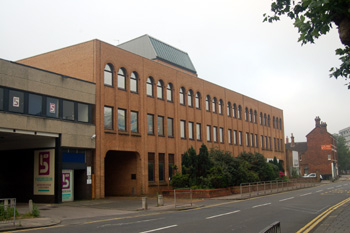Bedford Bridewell
![The Angel public house about 1900 - the building immediately to the left being the site of the Bridewell [Z50/9/789]](/CommunityHistories/Bedford/BedfordImages/The Angel about 1900.jpg)
The Angel public house about 1900 - the building immediately to the left being the site of the Bridewell [ref: Z50/9/789]
The terms 'House of Correction' and 'Bridewell' are used interchangeably. This usage arose from St Bride's Well, a holy well in London, near which Henry VIII had a lodging, donated by Edward VI for a hospital, which was then converted into a House of Correction. An Act of 1575 [ref: 18 Eliz.cap.3] required the Justices of the Peace for each county to set up a House of Correction to accommodate vagrants and the work-shy. The Bridwell in Bedford had a life of about 225 years from about 1585 until 1801.
The institutions were intended to provide work for the unemployed and to instil industrious habits. A proclamation at the General Sessions held at Bedford in 1585 [ref: CRT150/5, original in British Museum] outlined the intention to build a House of Correction. Originally it was administered by the County Justices but was eventually organised and run by professional gaol keepers, who were paid by the prisoner upon their discharge.
Bedford Bridewell was situated in Saint Mary's parish on the south side of Cauldwell Street. The first documentary reference to this occurs in the Quarter Sessions minutes of 4th October 1652, when Andrew Norris, a labourer from Ridgmont charged with an assault on William Hopkins, was sentenced '…to be in Bridewell a fortnight for his rude carriage in the court' [ref: QSM1 pg.17]. The building was immediately east of the Angel Inn, which was later numbered 12 Cauldwell Street, the Bridewell therefore being on the site of the later 10 Cauldwell Street. Today both buildings have been replaced by a modern commercial development which became Bedford Free School in 2012.
In 1724 John Okely was appointed keeper of the Bridewell 'for life…and he will put the prison in good and sufficient repair and so keep the same and tile all that part of it which is now thatch'd for the yearly salary of thirty pounds…and that he shall find straw and all other incidents' [ref: QSR1724/155].
In 1755 the architect Thomas Moore carried out repairs and many alterations to the Bridewell and the Bridewell Keeper's house; 'Take down the West front of the Bridewell being now only built with timber and build the said front with bricks' [ref: QSR1755/86]. In a deed of 1771 [ref: GK95/23] the Angel Inn was described as adjoining the house of Robert Furness, used as the County Bridewell. In 1783 John Howard described the Bridewell as consisting of three 13 feet 6 inches by 11 feet 6 inches rooms on the ground floor, no fireplace, and a courtyard 36 feet by 24 feet. It housed few prisoners, between two and four on his visits between 1776 and 1782, who had no water supply available to them.
In 1801 prisoners held at the Bridewell were transferred to the new County Gaol (which included a House of Correction), and at the Michaelmas Sessions that year Samuel Whitbread purchased the buildings and land of both the Bridewell in Saint Mary's and the old County Gaol site on the corner of Silver Street and the High Street. [ref: QSM1 p.86].
An outbreak of gaol fever at the Bridewell is recorded on a linked page.

The site of the Bridewell in July 2008